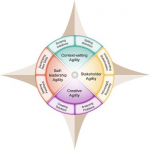How to use the Leadership Agility Compass
May 30, 2017 by Bill Joiner
Filed under Applications of Leadership Agility, Leadership coaching, Leadership development, Research on Agility, What is Leadership Agility?
 The Leadership Agility Compass is a graphic tool developed by ChangeWise, that emerged from the 5 years of intensive research and writing underlying the book, Leadership Agility. When you know how to use it, it’s a tool that can make any leadership initiative you undertake more effective.
The Leadership Agility Compass is a graphic tool developed by ChangeWise, that emerged from the 5 years of intensive research and writing underlying the book, Leadership Agility. When you know how to use it, it’s a tool that can make any leadership initiative you undertake more effective.
Our research on Leadership Agility found that the most effective leaders we studied invest time and attention in four key “territories.” These four territories are the same, regardless of whether an initiative involves leading organizational change, improving team performance, or engaging in pivotal conversations.
The four interrelated territories that are integral to any of these initiatives are:
- The larger systemic context surrounding your initiative.
- Your initiative’s key stakeholders.
- The specific problems and opportunities your initiative must address for it to be successful.
- Yourself as a leader.
Each point on the Leadership Agility Compass points to one of these territories, serving as a reminder to attend fully to all four. The Compass points themselves represent the four types of leadership agility you need to exercise in attending to these territories. The underlying dynamic of agility is the same for all four types: You step back from what you’re focused on, gain a wider perspective, and then move to put the key insights from this wider view into action. What is different about the four types of agility is that they each attend to different territories.
- Context-setting agility: Think of a specific real-life initiative you are planning or are already undertaking. Focus your mind on the doing of this initiative. Now, step back and let the larger strategic context of your initiative come into view. As you scan this larger environment, you recognize and anticipate changing circumstances, you decide which initiatives are most worth your time and effort – and why, and you clarify the outcomes you want each initiative to achieve.
- Stakeholder agility: Now, when you step back from focusing on your initiative, bring to mind its key stakeholders. These are the people and groups who will be impacted by your initiative and whose support you need for your initiative to be successful. As you step back and survey this territory, you can identify your stakeholders, then put yourself in their shoes: How do they view and feel about your initiative? To what extent are they aligned with what you want to do? To the extent that you are not aligned, how can you engage with them in ways that might lead to more optimal alignment?
- Creative agility: Another territory is made up of the specific issues your initiative needs to address. Creative agility starts with stepping back and identifying what these key issues are and how they are related. It also involves diagnosing the underlying root causes of these issues, and developing creative solutions. Why creative solutions? Due to the nature of today’s turbulent business environment, the problems that need to be addressed tend to be novel and non-routine and to cross organizational boundaries. Research has shown what you already probably know: The best solutions to these “ill-structured” problems come when we engage our capacity for creative thinking.
- Self-leadership agility: The fourth territory is, frankly, the most frequently overlooked. There is a saying: “Wherever you go, there you are.” You yourself are at the heart of everything you do as a leader. You activate your self-leadership agility when – before, during, and after an initiative you lead – you step back and reflect on yourself. Stepping back repeatedly in this way allows you to accelerate your own leadership development by clarifying your strengths and areas where you want to improve, proactively finding opportunities to stretch and grow as a leader, and reflecting your experiences as you continue to experiment toward higher levels of effectiveness.
Try it out and see what happens.
The Leadership Agility Compass is also at the heart of the innovative “Leadership Agility 360″ feedback instrument. It is also at the core of the Leadership Agility Change Lab, where leaders simultaneously advance their own change projects while increasing their agility as leaders.
If you are interested in leadership coaching or consulting that makes use of the Leadership Agility Compass and other practical insights from the ChangeWise research on leadership agility, contact me at bj@changewise.assessleadershipagility.com
 Bill Joiner is co-author of the award-winning book, Leadership Agility. He is CEO and a Principal Consultant at ChangeWise, a firm with international reach that specializes in leadership consulting, coaching and training; team development; and organizational change consulting.
Bill Joiner is co-author of the award-winning book, Leadership Agility. He is CEO and a Principal Consultant at ChangeWise, a firm with international reach that specializes in leadership consulting, coaching and training; team development; and organizational change consulting.
Follow Bill Joiner on Twitter – @agileleader

Bill, great summary of vertical leadership growth!